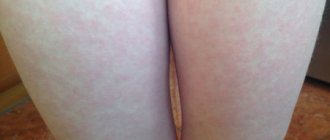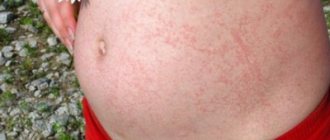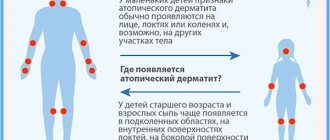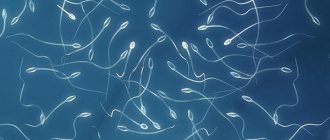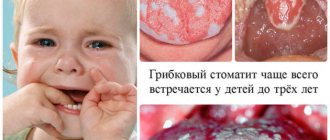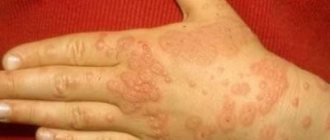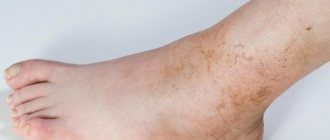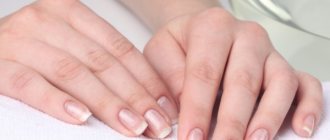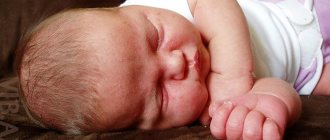Allergies in the form of red spots: causes of appearance and localization
Regardless of the nature of the skin rashes, they should alert you. In any case, this is a signal from the body to any internal problems or to external influences. And in the case of allergies, the most important thing is to eliminate its source. This is why it is important to understand that red spots on the face or body are allergic in nature.
The main causes of allergies and red spots include:
- Reaction to external irritants: allergies to household chemicals, cosmetics, animal hair, plants are most often accompanied by the appearance of red spots directly at the sites of contact with the allergen (also called contact dermatitis). The skin of the hands, feet, face, and neck suffers.
- Long-term use of medications, especially antibiotics, can also provoke an allergic reaction. Locations of allergies and the red spots that accompany them can be found throughout the body.
- Food allergies to certain allergenic foods and poor nutrition in general often cause the appearance of red spots in the abdomen, face, arms and legs. This reaction also occurs with vitamin deficiency or hypervitaminosis, i.e. when there are not enough vitamins or too many of them.
- Nervous exhaustion, stress, and unstable emotional state also affect the condition of the skin. If you have recently experienced a strong outburst of emotions, after which you noticed red spots on your body, this is a reason to consult a dermatologist and neurologist.
- The skin is irritated and red from allergies to cold and sun. More often, its manifestation is noticeable in areas of the skin that are most exposed to weather conditions due to the fact that they are not protected by clothing - these are the hands and face.
Diagnostics
In order to find out what exactly caused the allergic reaction, the child must be carefully examined. The doctor collects anamnesis and finds out what medications the patient has taken recently. During periods of exacerbation of allergies, skin allergy tests are not performed. They are prescribed during the period of remission.
Lab tests:
- determination of IgE antibodies (PACT) to penicillin, muscle relaxants, insulin;
- tryptase determination;
- study of immunoglobulins E, IgG and IgM;
- lymphocyte transformation occurs.
Allergy in a child in the form of red spots
Allergic spots appear especially often in young children. Moreover, the reaction can appear completely suddenly and on any part of the body. The reason should be, first of all, looked for in the menu of a baby or a nursing mother. The child's body instantly reacts to unusual foods or familiar ones, but in too large quantities.
If red spots appear on the child’s face, arms, legs, or in the groin area, they itch, peel, and begin to become wet, this may be diathesis. It develops as a result of malnutrition, food allergies, hormonal imbalance, and also due to improper functioning of the body.
Contact allergies occur when there is direct contact with an allergen. It could be washing powder, after which you didn’t rinse your laundry, synthetic or even woolen fabrics well. In this case, spots appear on the palms, cheeks and other parts of the body with which the baby came into contact with an aggressive surface.
Even after stopping contact with the irritant, spots on the skin remain for several days. If they cause discomfort to the baby, then the affected areas must be especially carefully cared for. In addition, constant itching causes scratching, which can become infected, and then serious skin treatment will be needed.
When the cause is not an allergy
Red spots on the skin do not only occur as a result of an allergic reaction.
- Infectious diseases make themselves felt at the development stage in the form of rashes on the body. They usually cover a large area of the dermis and are accompanied by an increase in temperature. Such diseases include chickenpox, measles, scarlet fever, rubella, ringworm, meningitis, and typhoid fever.
- Diseases of internal organs often manifest themselves in the form of skin rashes. The appearance of a red rash may indicate vegetative-vascular dystonia, disorders of the nervous system, an unhealthy stomach, heart, or the presence of tumor diseases.
- Dermatological nature of the rash. Most skin diseases manifest themselves in the form of skin hyperemia, expressed by obvious redness and itching. The most common cases are eczema, psoriasis, dermatitis, lupus erythematosus, seborrhea, and lichen.
Medicine knows more than fifty diseases that are accompanied by a similar symptom. Therefore, accurate diagnosis is very important, and only a specialized dermatologist can carry it out after a series of tests. He will also determine the exact allergen, if the cause of the appearance of red spots is still in it, and prescribe the appropriate treatment.
Characteristic signs and symptoms
How do allergies manifest in infants? Doctors identify several groups of negative symptoms. With a mild allergic reaction, two or three symptoms appear, and the baby’s condition is satisfactory. A severe form is a noticeable deterioration in well-being, the manifestation of many signs (some symptoms threaten the child’s life).
Negative skin reactions:
- purple blisters (the size of convex formations is from 0.5 to 12–15 cm);
- small allergic rash: blisters with liquid inside;
- red spots;
- white blisters with a red border (severe stage of giant urticaria);
- small red-pink spots, reminiscent of a nettle burn;
- papules with fluid;
- redness of the epidermis on the cheeks, forehead, chin. Hyperemia is also observed on the elbows, neck, under the knees, on the buttocks, in the groin folds;
- erythema;
- skin itching and burning;
- serous wells for eczema;
- crusts against a background of redness;
- seborrheic scales are yellow;
- wounds, ulcers, weeping of problem areas after opening of the blisters, leakage of exudate;
- an increase in local temperature, the addition of a fungal or bacterial infection due to scratching.
Negative reactions in the digestive tract:
- nausea;
- loss of appetite;
- vomit;
- painful colic;
- diarrhea;
- regurgitation;
- constipation.
General signs:
- labored breathing;
- bronchospasm;
- decrease in pressure;
- insomnia, moodiness due to severe itching;
- anxiety or, conversely, drowsiness;
- increased heart rate;
- fever (rare).
How to treat red spots due to allergies
As mentioned earlier, the most important thing is to eliminate the source of the allergy. Sometimes this is enough to prevent its development. Wash off any cosmetics that cause irritation, eliminate allergen products from your diet, and wash your hands thoroughly after using household chemicals.
If you cannot find the cause of the red spots on your own and their appearance is accompanied by other unpleasant symptoms, consult a doctor. Just a few laboratory tests will reveal what exactly you are allergic to, or diagnose that the nature of the skin irritation is not allergic in nature.
The doctor will prescribe antihistamines for oral administration and special ointments that relieve symptoms. In advanced cases of allergies, corticosteroids may be required.
Susceptibility to certain allergens may increase depending on the general condition of the body: illness, stress. So, to eliminate red allergic spots, you need to follow a healthy lifestyle. You may need to adjust your diet and regimen. Give up bad habits, try to spend more time outdoors. But do not forget to wear gloves in cold weather or use sunscreen in summer, otherwise you may develop an allergy to the cold and sun.
During treatment, limit visits to baths and saunas so that irritated skin is not subjected to even greater stress. Try not to abuse alcohol - sometimes allergies in the form of red spots occur to it.
You can relieve such unpleasant symptoms that accompany the appearance of skin irritation, such as itching and peeling, using folk remedies. A decoction of oak bark, birch leaves, and herbal tinctures are effective - they should be used to wipe red spots that itch in case of allergies.
Irritated skin requires special delicate care. During treatment, give up regular cosmetics (who knows, maybe it’s what caused the allergy) and use special products to cleanse the skin.
The La-Cri series helps well against red spots due to allergies. The La-Cri cosmetic complex helps with skin allergies, helping children and adults equally gently and effectively. Cleansing gel provides delicate hygiene for both dry and wet stains. A light cream relieves redness, itching and flaking, promoting skin restoration. Due to the absence of dyes and fragrances, La-Cri products are non-addictive and suitable for long-term use.
Traditional medicine
The use of traditional methods to eliminate signs of an allergic reaction in infants relieves itching, flaking, and skin irritation:
- Infusions of chamomile, string, sage. They have a healing, anti-inflammatory effect. Used as lotions or adding decoctions when bathing.
- To soften hard, dry scales, burdock oil is used, which is applied to damaged areas, facilitates the removal of yellow scaly plates and moisturizes flaky skin on the scalp.
Consumer Reviews
Dasha0708 about La Cree cream for sensitive skin (spasibovsem.ru)
“I want to share my impressions about La-Cri cream. A couple of days ago I decided to inspect the balcony. I have a terrible allergy to dust, well, naturally, after 5 minutes of being in a huge amount of old trash, I began to itch and sneeze terribly. Usually in these cases, fenkarol and suprastin help me, but I didn’t have it at home. Luckily, my sister came to see me with a small child and left me La-Cri Cream.”
Her baby had rashes and she applied this same cream to them) I immediately began to read the instructions and scope of application. I was very pleased with what I read there) The composition of the cream is almost entirely from natural products. In general, I smeared all my “itches”, red spots and just places where I wanted to scratch. After just a minute of application, the itching began to subside, and after a couple of minutes all the red spots disappeared. I am very pleased with such a quick effect. Now this cream is my first assistant!! I recommend!!!"
tiho-mirno about La-Cri emulsion (otzovik.com)
“I became acquainted with this product after receiving samples at the maternity hospital. For almost three months, a small bag of emulsion waited for its “finest” hour - and it did (they started using a sample of the cream much earlier). My little daughter and I went to visit my parents in the region. Mountains, sun, fresh air are great, of course, but a baby at that age cannot express his delight. But from visiting the bathhouse - quite good. You can't get it out of there by the ears! One problem: the village water didn’t do us much good. The skin became completely dry, red and began to peel off. Baby oil did not save the situation, alas. Arriving in the city, I remembered the sample with the emulsion. We decided to try it - oh, miracle! — helped with one application. Light, pleasant consistency, absorbs very quickly, unobtrusive sweet aroma. The very next day there was a noticeable improvement, even the doctor at the clinic noticed it. Now we’re thinking about purchasing the “full version” - it will always come in handy.”
Sources:
- Reken Martin, Schaller Martin, Sattler Elke, Burgdorf Walter, Atlas of Dermatology, MEDpress-inform, 2021.
- Andropova T. V., Gudina M. V., Odintsova I. N., Hygiene of children and adolescents, Siberian State Medical University Publishing House, 2021.
- Cohen Bernard A. Pediatric dermatology, MEDpress-inform, 2015.
Photos of allergies in children
Photo album on the diseasePrevention measures
To avoid allergies to medications in children, first of all you need to stop self-medicating . Children who are prone to allergic reactions should be especially careful when choosing medications. Be sure to notify your doctor about them.
If the child has already had a reaction to a certain drug, it must be excluded and a suitable alternative must be found. All data on drug intolerance should be clearly recorded in the patient’s outpatient record. Always follow the dosage when taking medications. Store them correctly and do not use them after the expiration date. Monitor drug combinations carefully. It is best to avoid taking multiple medications at once.
Why do children have allergic reactions to certain medications? How to recognize a drug allergy, what precautions should be remembered if the child already has a drug allergy to certain drugs? Is this problem inherited and are popular skin tests indicative? The famous children's doctor Komarovsky will talk about this and much more in the following video:
What about medications?
Antihistamines are used to treat allergies. Histamine is a special compound that is usually stored inside cells in a dormant state. During an allergic reaction, histamine is released from cells and triggers an inflammatory response. Medicines should prevent this: neutralize histamine and prevent it from leaving the storage facility again.
Antihistamines do not eliminate the cause of the reaction - the allergen, but they help remove its symptoms and improve the quality of life.
There are many antihistamines available. Old ones, created several decades ago, have more side effects than new ones. For example, they cause drowsiness or dry mucous membranes. Drops have been developed for children that are more convenient to take than tablets. There are also ointments that are used for skin allergy symptoms.
We do not specifically name the drugs, because they are sold freely and there is always a temptation to prescribe something for a child’s allergies without understanding the intricacies. But the doctor must select a treatment regimen, especially for children.
How to distinguish allergies from other problems
Allergy is a diagnosis that you are tempted to make on your own, because it seems simple and obvious. But you can’t do that. Other diseases can be disguised as allergies: from lichen to asthma.
Diagnosis of allergies begins with a detailed survey: the doctor must understand what possible allergens the child has encountered recently. The doctor will ask many questions that need to be answered honestly and thoroughly. Sometimes it’s embarrassing to admit that you gave your child harmful soda, but you can’t hide this fact from the doctor (especially, believe me, the doctor has never seen anything like this).
After the interview, the doctor checks which allergens there is a reaction to. They do this in two main ways.
Skin tests
A scratch is made on the skin of the forearm, onto which an allergen extract is applied. Through a scratch, the allergen enters the bloodstream, and the reaction shows which substances are the cause of the symptoms. The result of such a test is noticeable within 20–30 minutes.
Sometimes, instead of scratches, injections or applications are made with a solution of Allergies Diagnosis allergen extract. For the examination to be reliable, you must not take allergy medications for several days before the examination—they must leave the body.
Contraindications to skin tests:
- Exacerbation of allergies.
- Exacerbation of other chronic diseases.
- Infections (that is, if a child catches a virus, tests are not done).
These tests can be done at any age Skin Tests - The Mainstay of Allergy Testing. Babies are tested for a small number of allergens. And the results obtained may change as the child grows. So the tests should be redone when the child is at least five years old.
Blood analysis
For this test, blood is drawn like most other tests. You will have to wait several days for the result, but a blood test is the solution when allergy tests are impossible ALLERGY TESTING. For example, when the exacerbation is prolonged.
The purpose of other examinations is to exclude diseases that pretend to be allergies. If you have difficulty breathing, suspect asthma and test your lung function; if you have a stuffy nose, suspect sinusitis (sinus infection) and take an x-ray.
General principles for the treatment of allergic urticaria in adults and children:
- Measures are taken to quickly remove allergic substances: cleansing enemas, laxatives, drinking plenty of fluids. To treat patients with severe disease, timely hospitalization is necessary.
- The diet is rational and complete, with limited dietary salt. Potentially allergenic products, histamine liberators, spicy and sweet foods, with flavors and dyes are prohibited. When hay fever and urticaria are combined, the following foods are prohibited from consumption: nuts and seeds, fruit juices, peaches, apricots, bread and flour products, vegetable oil. This food has common biochemical characteristics with pollen from trees and grasses, and can provoke a relapse of the disease.
- Regulation of work and rest modes and a good night's sleep are shown. It is recommended to avoid significant sports activities, emotional stress, and bad habits.
- A prerequisite for successful treatment of urticaria is the rehabilitation of chronic foci of infection (caries, otitis, tonsillitis, pharyngitis, arthritis, furunculosis, helminthiasis).
Drug treatment depends on the severity of the process - with a mild course of the disease, it is enough to carry out elimination measures and prescribe antihistamines of 1-2 generations. Moderate severity of the disease should be treated with 1st generation antihistamines parenterally, if there is no effect - with general glucocorticosteroids. After achieving the desired effect, switch to a course of second-generation histamine blockers for 1 month.
Severe urticaria requires an expanded range of therapeutic measures:
- elimination techniques listed above,
- 1st generation histamine blockers intravenously in age-specific doses,
- the next step in treatment is systemic steroid hormones in high doses,
- carrying out detoxification infusion therapy with the addition of diuretic drugs - according to indications (cerebral edema),
- after the patient’s well-being improves, conduct a course of antihistamines lasting 1-2 months.
